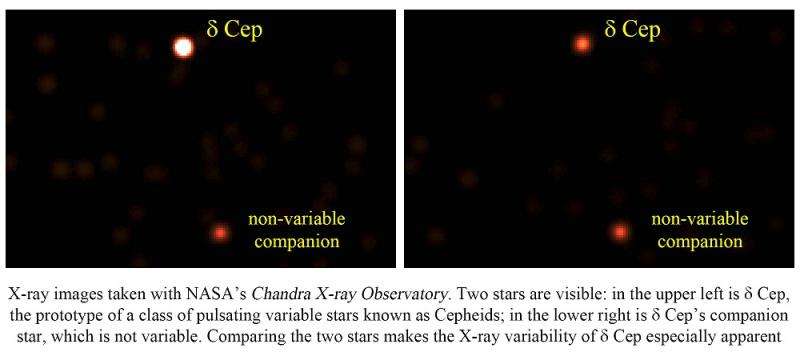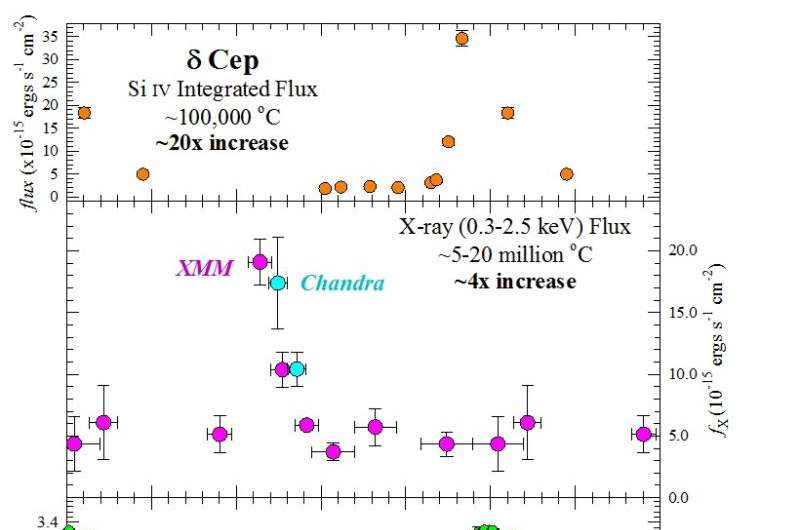The surprising discovery of a new class of pulsating X-ray stars

A surprising new class of X-ray pulsating variable stars has been discovered by a team of American and Canadian astronomers led by Villanova University's Scott Engle and Edward Guinan. Part of the Villanova Secret Lives of Cepheids program, the new X-ray observations, obtained by NASA's Chandra X-ray Observatory and published Thursday, March 23rd in the Astrophysical Journal, reveal that the bright prototype of Classical Cepheids, d Cephei, is a periodic pulsed X-ray source.
Research team members sharing in the discovery included Graham Harper, University of Colorado; Nancy Remage Evans, Harvard Center for Astrophysics; Manfred Cuntz, University of Texas, Arlington; and Hilding Neilson, University of Toronto.
The prototype star after which all Cepheids are named, d Cephei (d Cep) is, at a distance of 890 light years away, also one of the closest of its type. Cepheids are a famous class of pulsating variable stars and among the most astronomically important objects in the Universe. By measuring the pulsation periods and brightness of Cepheids astrophysicists can measure distances to other galaxies and calibrate the extragalactic distance scale. Cepheids also play an increasingly vital role in the effort to precisely measure the expansion rate of the Universe and to resolve the developing Hubble discrepancy.
Data recently returned for d Cep from the Chandra X-ray Observatory, combined with previous X-ray measures secured with the XMM-Newton X-ray satellite, have shown that d Cep has X-ray variations occurring in accord with the supergiant star's 5.4 day pulsation period. X-rays are observed at all phases of the star's pulsations, but sharply rise by ~400% near the times when the star swells to its maximum diameter of about 45 times that of the Sun.
"Our first X-ray observations of Cepheids were made in 2006, and our first detections were met with a good bit of skepticism. The notion that Cepheids could be X-ray active seemed far-fetched because these stars are only a few times more massive and a little hotter than the Sun," said Engle. "Over a decade later, we've finally shown that they can in fact be X-ray variable, but the work is far from over. Now we need to understand just how they generate and modulate their X-ray emissions, and what effect this could have on the Leavitt Period-Luminosity Law."

d Cep is a bright star, easily seen without a telescope to the North in the constellation Cepheus. This yellow supergiant star, whose optical brightness variations were discovered in 1784, was one of the first variable stars known. Its light variations are the result of radial pulsations, in which the star contracts and expands with the same 5.4 day period as its brightness variations. The surface of d Cep reaches supersonic speeds of about 82,000 miles per hour, while the star shrinks and grows by roughly 2 million miles during each pulsation period. Thousands of Cepheids have been found in our galaxy as well as in other galaxies hundreds of millions of light years away.
Analyses of the X-ray data indicate the unexpected presence of very hot plasmas in d Cep, with temperatures above 10 million degrees Celsius. It is not certain yet whether the X-rays arise from pulsation-induced shock waves in the star's dynamic atmosphere, or from the generation of a stellar magnetic field that becomes tangled, emitting X-rays. Other Cepheids are being studied to understand the source of the heated, X-ray emitting plasmas. At least two additional Cepheids show potential X-ray variability.
The research team led by Engle and Guinan previously used the Hubble Space Telescope to study ultraviolet emission lines from d Cep and other Cepheids. These emission lines originate in plasmas of up to 300,000 degrees Celsius; cooler than X-ray emitting plasmas but still far hotter than the surfaces of the stars. The ultraviolet emissions also vary in accord with the Cepheids' pulsation periods but sharply rise after the Cepheid reaches minimum radius, as opposed to the X-ray emissions which peak just after maximum radius. The team is still studying exactly why the ultraviolet and X-ray emissions peak at such different phases of the star's pulsations.
"Classical Cepheid stars are considered to be the most important variable stars in the sky. These pulsating supergiant stars have been used since the mid-1920s by Edwin Hubble and other astronomers to measure the distances to galaxies and determine the expansion rate of the universe," said Guinan. "After many tries, the failure to detect X-rays from Cepheids during the 1980-90s led astronomers to give up on them as potential X-ray stars. So it was a big (but pleasant) surprise to find X-ray emission from d Cep and several other Cepheids."
This discovery of X-rays for d Cep and some other Cepheids is the newest in a list of recently discovered Cepheid properties. These include circumstellar gas and dusty environments, infrared excesses, ultraviolet emission lines, and cycle-to-cycle variations in the stars' periodic light changes. This combination of discoveries shows that Cepheids, after more than two centuries of study, still have their secrets. Given the astrophysical and cosmological importance of Cepheids, and the high precisions required to test cosmological models, these new discoveries should be better understood. X-ray observations of other bright Cepheids are planned to unravel their X-ray behavior.
Journal information: Astrophysical Journal
Provided by Villanova University





















